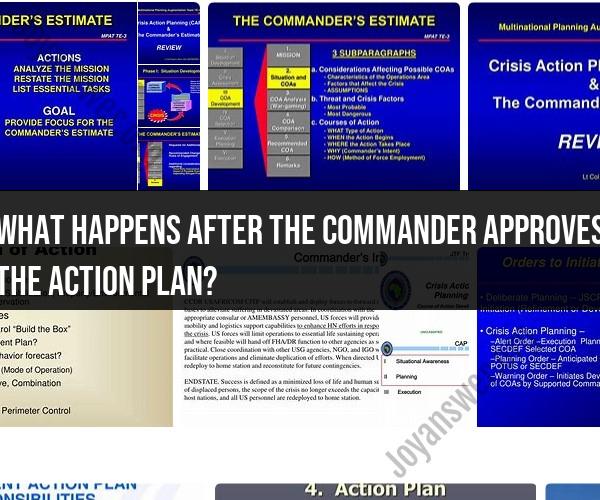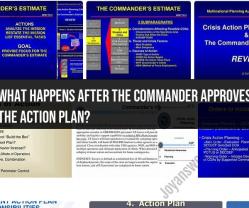What happens after the Commander approves the action plan?
After a Commander approves an action plan, several key steps typically follow to implement the plan effectively. The exact process may vary depending on the organization, mission, and specific circumstances, but here is a general overview of what happens next:
1. Communication and Briefing:
- The Commander or responsible authority communicates the approved action plan to all relevant personnel involved in the operation or project. This includes briefing key individuals on their roles and responsibilities.
2. Task Assignment:
- Tasks and responsibilities are assigned to specific team members or units based on their expertise, skills, and roles within the organization. Clear task assignments help ensure that everyone knows what they need to do.
3. Resource Allocation:
- Resources such as personnel, equipment, funds, and materials are allocated as needed to support the plan's execution. This may involve logistics and supply chain management.
4. Execution and Implementation:
- The action plan is put into action according to the specified timeline and sequence. This often involves coordinated efforts by multiple teams or units to achieve the plan's objectives.
5. Monitoring and Control:
- Ongoing monitoring and control mechanisms are established to track progress, assess performance, and make necessary adjustments. Key performance indicators (KPIs) and milestones are used to measure success.
6. Reporting and Feedback:
- Regular reporting mechanisms are in place to provide updates on the plan's progress and any challenges encountered. Feedback from the field helps decision-makers stay informed and make informed adjustments if needed.
7. Contingency Planning:
- Contingency plans and backup strategies are developed to address unexpected developments or obstacles that may arise during the execution phase. These plans ensure flexibility and adaptability.
8. Risk Management:
- Risk management strategies are implemented to identify, assess, and mitigate potential risks and uncertainties that could affect the success of the plan.
9. Coordination and Collaboration:
- Effective coordination and collaboration among different teams, units, or departments are crucial to ensure a synchronized effort and efficient use of resources.
10. Documentation:- Comprehensive documentation of the plan's execution, including records of actions taken, decisions made, and outcomes achieved, is essential for accountability and analysis.
11. Evaluation and Review:- After the plan's completion or at specified intervals, a thorough evaluation and review process takes place to assess the overall success, identify lessons learned, and determine areas for improvement.
12. Reporting to Higher Authorities:- Depending on the organization's structure, the results and outcomes of the action plan may be reported to higher authorities, stakeholders, or oversight bodies.
13. Follow-Up Actions:- Based on the evaluation and review, follow-up actions may be initiated to address any outstanding issues, implement improvements, or plan for the next phase of the mission or project.
14. Lessons Learned:- Lessons learned from the execution of the action plan are documented and shared within the organization to inform future planning and decision-making.
The process of executing an action plan is dynamic and iterative, and it requires close coordination, communication, and adaptability among team members and leaders. The ultimate goal is to achieve the desired outcomes efficiently and effectively while addressing any challenges that may arise along the way.


